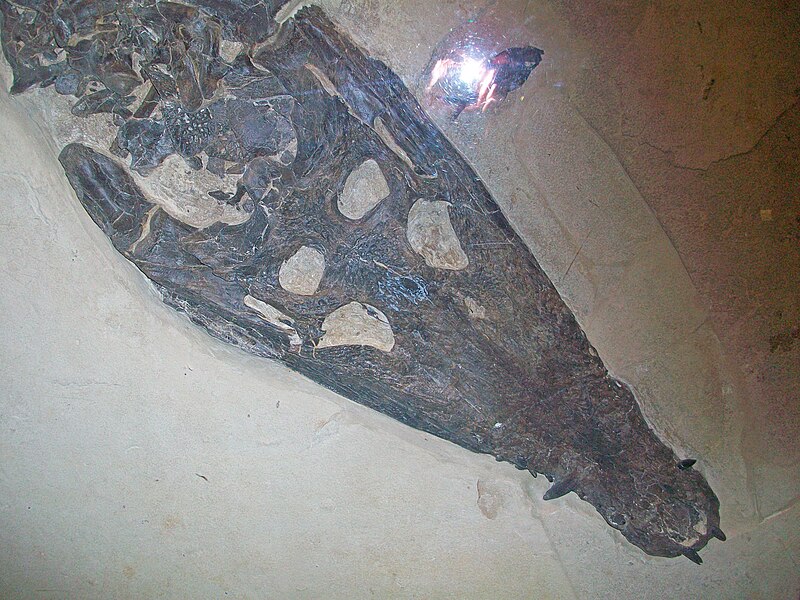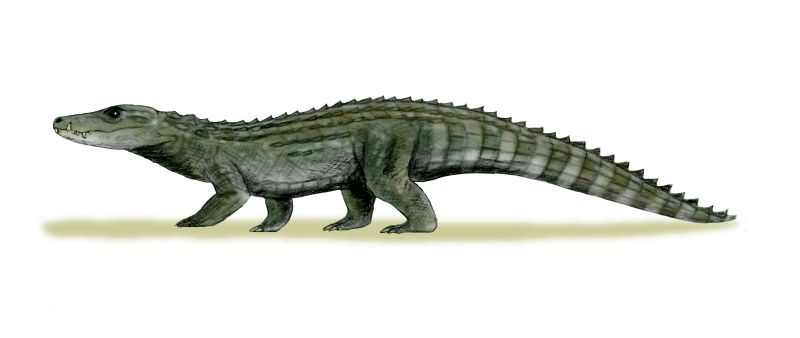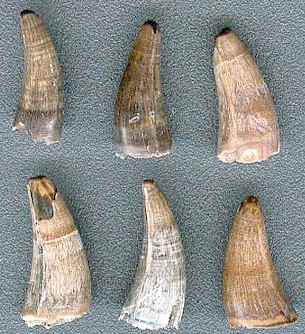[Recent Entries][Archive][Friends][User Info]
April 14th, 2014
| April 14th, 2014 | |
|---|---|
| 08:37 pm [industrialterro] [Link] |
Borealosuchus Borealosuchus is an extinct genus of crocodylians that lived from the Late Cretaceous to the Eocene in North America. It was named by Chris Brochu in 1997 for several species that had been assigned to Leidyosuchus. The species assigned to it are: B. sternbergii, the type species, from the Maastrichtian (Late Cretaceous) of Colorado, Montana, North Dakota, South Dakota, and Wyoming; B. acutidentatus, from the Paleocene of Saskatchewan; B. formidabilis, from the Paleocene of North Dakota and Wyoming; B. griffithi, from the Paleocene of Alberta; and B. wilsoni, from the Eocene of Wyoming. B. formidabilis is particularly well-known, represented by the remains of many individuals from the Wannagan Creek site in North Dakota. Borealosuchus was a mid-sized crocodylian; B. acutidentatus reached up to 2.8 metres (9.2 ft) in length with a 36 centimetres (14 in) skull. Six species of Borealosuchus are currently recognized. In order of their naming, they are B. sternbergii, B. acutidentatus, B. wilsoni, B. formidabilis, B. griffithi, and B. threeensis. Four of these species (B. sternbergi, B. acutidentatus, B. wilsoni, and B. formidabilis) were originally named as species of Leidysuchus. A sixth species of Borealosuchus, B. threeensis, was named in 2012. Fossils of this species were found in the Inversand Company Marl Pit of Gloucester County, New Jersey. The specific name is a reference to Exit 3 of the New Jersey Turnpike, which is the closest highway exit to the type locality. The authors of the paper describing B. threeensis noted that the name is "in reference to a question every New Jersey resident encounters when traveling: 'Oh, you’re from New Jersey? Which exit?". According to Brochu et al. (2012) most phylogenetic analyses recovered Borealosuchus as a crocodylian more closely related to the clade Brevirostres than to Gavialoidea; a few recovered it as more closely related to gavialoids or as a basal eusuchian not belonging to Crocodylia. According to Brochu and coauthors' (2012) own analysis, all three hypotheses are equally parsimonious. Ископаемые останки (1, 2, 3, 4): Tags: Вымершие рептилии, Мел, архозавроморфы, архозавры, диапсиды, крокодиломорфы, крокодилы, круротарзы, мезоэукрокодилии, неозухии, равизухии, эузухии |
| Time | Event |
| 08:48 pm [industrialterro] [Link] |
Allodaposuchus Allodaposuchus is an extinct genus of eusuchian crocodylomorph and an early relative of crocodilians. It lived during the Upper Cretaceous (Campanian-Maastrichtian) in Southern Europe (Spain, Romania, and France). Like many other Cretaceous crocodylomorphs, Allodaposuchus has a relatively small body size compared to living crocodylians. The largest known specimen of Allodaposuchus belongs to an individual that was probably around 3 metres (9.8 ft) long. Allodaposuchus has a short, flattened, and rounded skull. Of the two known species, A. precedens has a brevirostrine or "short-snouted" skull with a snout about the same length as the skull table (the region of the skull behind the eye sockets) and A. subjuniperus has a mesorostrine or "middle-snouted" skull with a snout that is longer than the skull table. The main feature that distinguishes Allodaposuchus species from other related crocodylomorphs is the orientation of a groove at the back of the skull called the cranioquadrate passage; unlike the cranioquadrate passages of other crocodylomorphs, which are only visible at the back of the skull, the cranioquadrate passage of Allodaposuchus is visible when the skull is viewed from the side. The type species of Allodaposuchus, A. precedens, was named by Hungarian paleontologist Franz Nopcsa in 1928 from Vălioara, Romania. Nopcsa found bone fragments in a deposit of the Hațeg Basin that dates back to the late Maastrichtian stage - the very end of the Late Cretaceous. Several partial skulls from Spain and France were attributed to A. precedens in 2001. Some of these skulls came from Campanian-age deposits slightly older than those in Romania, meaning that the species must have persisted for about 5 million years. In 2013 a second species of Allodaposuchus, A. subjuniperus, was named on the basis of a skull from the late-Maastrichtian Conqués Formation in the province of Huesca, Spain. The skull was found underneath a juniper tree whose roots had grown between the bones, hence the species name subjuniperus or "under juniper" in Latin. The 2013 study also proposed that the French and Spanish fossils assigned to A. precedens in 2001 might actually represent a new unnamed species of Allodaposuchus currently identified as Allodaposuchus sp. A study published in 2005 had suggested that these fossils belong to several different genera of crocodylomorphs and that the original Romanian material is too fragmentary to assign to its own genus, making Allodaposuchus a nomen dubium or "dubious name". However, the 2013 study reaffirmed the Romanian material's distinctiveness from other European Cretaceous crocodylomorphs and therefore reaffirmed the validity of Allodaposuchus as a genus. Allodaposuchus is a close relative of modern crocodylians but it is not itself a member of Crocodylia, the most exclusive group including all modern crocodylians. It is an early member of a larger clade or evolutionary group called Eusuchia that originated in the Early Cretaceous. Allodaposuchus is part of an evolutionary radiation of eusuchians that happened later in the Cretaceous as they spread to multiple continents. When Franz Nopcsa named Allodaposuchus, he proposed that it was a close relative of Leidyosuchus, a crocodylian from Canada. However, Nopsca could only base this assignment on a few fragments of bone. After more complete material was uncovered from Spain and France, Allodaposuchus was reinterpreted as a non-crocodylian eusuchian in 2001. The 2001 study recognized a close relationship between Allodaposuchus and Hylaeochampsa, a eusuchian from the Early Cretaceous of England. A 2010 phylogenetic analysis supported a relationship similar to Nopsca's by placing Allodaposuchus within Alligatoroidea, a group of crocodylians that includes modern-day alligators and Leidyosuchus. Tags: Вымершие рептилии, Мел, архозавроморфы, архозавры, диапсиды, крокодиломорфы, круротарзы, мезоэукрокодилии, неозухии, равизухии, эузухии |
| Time | Event |
| 09:36 pm [industrialterro] [Link] |
Thoracosaurus Thoracosaurus is an extinct genus of gavialoid crocodilian which existed during the Late Cretaceous and early Paleocene. It contains the species Thoracosaurus neocesariensis in North America and Thoracosaurus macrorhynchus in Europe. A number of species have been referred to this genus, but most are dubious. Thoracosaurus scanicus was a fairly large gavialid, with a length of more than 4.4 m (14.4 ft) and a 55 cm skull. European fossil remains from Thoracosaurus have been discovered in Ivö Klack on Ivö in Skåne, Sweden, and Denmark. Gavialoidea is one of three superfamilies of crocodylians, the other two being Alligatoroidea and Crocodyloidea. Although many extinct species are known, only the gharial Gavialis gangeticus and the false gharial Tomistoma schlegelii are alive today. Gavialoidea contains the family Gavialidae and several more basal extinct forms such as Thoracosaurus and Eosuchus. Within Gavialidae are two subfamilies: Gavialinae, which includes the living gharial, and Gryposuchinae, which includes several extinct forms such as Gryposuchus and Aktiogavialis. In addition to these groups, recent molecular studies consistently indicate that the false gharial (and by inference other related extinct forms) traditionally viewed as belonging to the crocodylian subfamily Tomistominae actually belong to Gavialoidea. As its name suggests, the false gharial was once thought to be only distantly related to the gharial despite its similar appearance. The false gharial and other tomistomines were traditionally classified within the superfamily Crocodyloidea as close relatives of crocodiles. This classification is based on morphological evidence, which, when incorporated into phylogenetic analyses, often place the group within Crocodyloidea. Ископаемые останки (1, 2, 3, 4, 5): Tags: Вымершие рептилии, Мел, архозавроморфы, архозавры, гавиалы, диапсиды, крокодиломорфы, крокодилы, круротарзы, мезоэукрокодилии, неозухии, равизухии, эузухии |
| Time | Event |
| 09:52 pm [industrialterro] [Link] |
Leidyosuchus Leidyosuchus (meaning "Leidy's crocodile") is an extinct genus of alligatoroid from the Late Cretaceous of Alberta. It was named in 1907 by Lawrence Lambe, and the type species is L. canadensis. It is known from a number of specimens from the middle Campanian age Dinosaur Park Formation. It was a medium-sized alligatorid, with a maximum skull length greater than 40 centimeters (16 in). A number of species had been assigned to this genus over the years, including: L. acutidentatus (Sternberg, 1932), from the Paleocene of Saskatchewan; L. formidabilis (Erickson, 1976), from the Paleocene of North Dakota and Wyoming; L. gilmorei (Mook, 1942), from the Campanian of Alberta; L. multidentatus (Mook, 1930); L. riggsi (Schmidt, 1938); L. sternbergii (Gilmore, 1910), from the Maastrichtian (Late Cretaceous) of Colorado, Montana, North Dakota, South Dakota, and Wyoming; and L. wilsoni (Mook, 1959), from the Eocene of Wyoming. However, in 1997 Chris Brochu reevaluted the genus and reassigned most of the species, transferring L. acutidentatus, L. formidabilis, L. sternbergii, and L. wilsoni to the new genus Borealosuchus, and L. multidentatus to the new genus Listrognathosuchus, proposing L. gilmorei as a synonym of L. canadensis, and finding L. riggsi to be too fragmentary to be determinable. Alligatoroidea is a superfamily of crocodilians that evolved in the Late Cretaceous period. Cladistically, it is defined as Alligator mississippiensis (the American alligator) and all crocodylians more closely related to A. mississippiensis than to either Crocodylus niloticus (the Nile crocodile) or Gavialis gangeticus (the gharial). Tags: Вымершие рептилии, Мел, аллигатороиды, архозавроморфы, архозавры, диапсиды, крокодиломорфы, крокодилы, круротарзы, мезоэукрокодилии, неозухии, равизухии, эузухии |
| Previous Day | 2014/04/14 [Archive] |
Next Day |





















